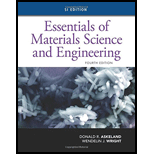
(a)
Interpretation:
The use of uniaxial compaction and sintering should be explained.
Concept Introduction:
Sintering is a process where heat or pressure is applied to compact and form solid mass without melting it. It happens naturally in mineral deposits or used as manufacturing plastics and other materials. There are sintering parameters as follows:
- High-density compact nanomaterials.
- Microwave sintering, etc.
(b)
Interpretation:
The use of hot pressing should be explained.
Concept Introduction:
Hot pressing is a process of high pressure, low strain rate metallurgical process for forming a powder or compacting powder at high temperature to induce sintering and creeping process.
The process is carried out by simultaneous action of pressure and heat.
This technique is used to produce metal and ceramic-based composites that are simple and versatile.
(c)
Interpretation:
The use of HIP should be determined.
Concept Introduction:
HIP stands for hot isostatic pressing process.
It is the manufacturing process used to reduce the porosity of metals and improve the density of ceramics materials. By achieving these properties, it eventually improves the materials
(d)
Interpretation:
The use of tape casting should be determined.
Concept Introduction:
The process of making ceramic tapes from ceramics slurry is called as tape casting. It is a type of casting process also called doctor blading and knife coating. The ceramic slurry is cast in a thin layer onto a flat surface and later dried and sintered.
Tape casting was famous as mass produce capacitor methods.
Want to see the full answer?
Check out a sample textbook solution
Chapter 15 Solutions
Essentials Of Materials Science And Engineering, Si Edition
- Deformation of a retaining wall is assumed to be as presented in the figure below. Determine:a) variation of the active and passive pressures on the wall for the presented deformation b) magnitude of the total horizontal force on the right side of the wall.arrow_forward2. a) Consider a cable used for aerial tramway (see figure a). The span is 400 m. The unstretched length of the cable is 402 m. Its mass per unit length is 10kg. The elasticity EA = 10 N. Find the horizontal load on the two ends and the sag d. Determine if the small sag condition is satisfied. b) When a cable car whose mass is 500kg is hung below the cable at a horizontal distance of 100 m from the left end, find the horizontal load on the ends. C) As the car goes along the cable, at which position you will see maximum horizontal load on the two ends?arrow_forwardusing the theorem of three moments, find all the reactions and supports, I need concise calculations only. the answers are at the bottom, I need concise steps and minimal explanationsarrow_forward
- In an industrial facility, a counter-flow double-pipe heat exchanger uses superheated steam at a temperature of 155°C to heat feed water at 30°C. The superheated steam experiences a temperature drop of 70°C as it exits the heat exchanger. The water to be heated flows through the heat exchanger tube of negligible thickness at a constant rate of 3.47 kg/s. The convective heat transfer coefficient on the superheated steam and water side is 850 W/m²K and 1250 W/m²K, respectively. To account for the fouling due to chemical impurities that might be present in the feed water, assume a fouling factor of 0.00015 m² K/W for the water side. The specific heat of water is determined at an average temperature of (30+70)°C/2 = 50°C and is taken to be Cp J/kg-K. Water Steam Determine the heat exchanger area required to maintain the exit temperature of the water to a minimum of 70°C. The heat exchanger area required isarrow_forwardSolve this problem and show all of the workarrow_forwardConsidering the TM example of binary sum ( see attached)do the step-by-step of execution for the binary numbers 1101 and 11. Feel free to use the Formal Language Editor Tool to execute it; Write it down the current state of the tape (including the head position) and indicate the current state of the TM at each step.arrow_forward
- Two square surface footings are placed 20 feet apart. Calculate ultimate settlements beneath footing I and at the centerline of the two footings.arrow_forwardFind the bending moment diagram for. structure drawn below using castigliani's Second theorems. 10kN/m A B 5m 10marrow_forwardDesign the foundation in Problem 3 (find the radius), for the assumptions that the failure isgeneral, sand is dry, loading Q=6000 kN, and the factory of safety is 2.4.arrow_forward
- Assume that the moist unit weight of sand in Problem 1 to be 122 lb/ft3, the saturated unit weight of sand 130 and clay 120 lb/ft 3. What should be the thickness of a soil layer of a unit weight of 120 lb/ft 3 that would cause consolidation settlement of 0.1 ft in 100 days?arrow_forwardDefine the allowable bearing capacity of a circular foundation of a radius 2R=10 ft using theTerzaghi's bearing capacity equation for a local failure. In your calculations assume two scenarios:a) that the ground water table matches the bottom of the foundation, and b) that the ground watertable is 6 ft below the bottom of the foundation. Use a factor of safety of 2.8, and the dry unit weightabove the ground water table.arrow_forwardQ2: Draw the layout of a basic asynchronous 32k * 8 SRAM.arrow_forward
 MATLAB: An Introduction with ApplicationsEngineeringISBN:9781119256830Author:Amos GilatPublisher:John Wiley & Sons Inc
MATLAB: An Introduction with ApplicationsEngineeringISBN:9781119256830Author:Amos GilatPublisher:John Wiley & Sons Inc Essentials Of Materials Science And EngineeringEngineeringISBN:9781337385497Author:WRIGHT, Wendelin J.Publisher:Cengage,
Essentials Of Materials Science And EngineeringEngineeringISBN:9781337385497Author:WRIGHT, Wendelin J.Publisher:Cengage, Industrial Motor ControlEngineeringISBN:9781133691808Author:Stephen HermanPublisher:Cengage Learning
Industrial Motor ControlEngineeringISBN:9781133691808Author:Stephen HermanPublisher:Cengage Learning Basics Of Engineering EconomyEngineeringISBN:9780073376356Author:Leland Blank, Anthony TarquinPublisher:MCGRAW-HILL HIGHER EDUCATION
Basics Of Engineering EconomyEngineeringISBN:9780073376356Author:Leland Blank, Anthony TarquinPublisher:MCGRAW-HILL HIGHER EDUCATION Structural Steel Design (6th Edition)EngineeringISBN:9780134589657Author:Jack C. McCormac, Stephen F. CsernakPublisher:PEARSON
Structural Steel Design (6th Edition)EngineeringISBN:9780134589657Author:Jack C. McCormac, Stephen F. CsernakPublisher:PEARSON Fundamentals of Materials Science and Engineering...EngineeringISBN:9781119175483Author:William D. Callister Jr., David G. RethwischPublisher:WILEY
Fundamentals of Materials Science and Engineering...EngineeringISBN:9781119175483Author:William D. Callister Jr., David G. RethwischPublisher:WILEY





